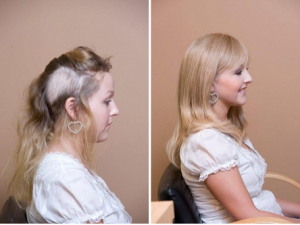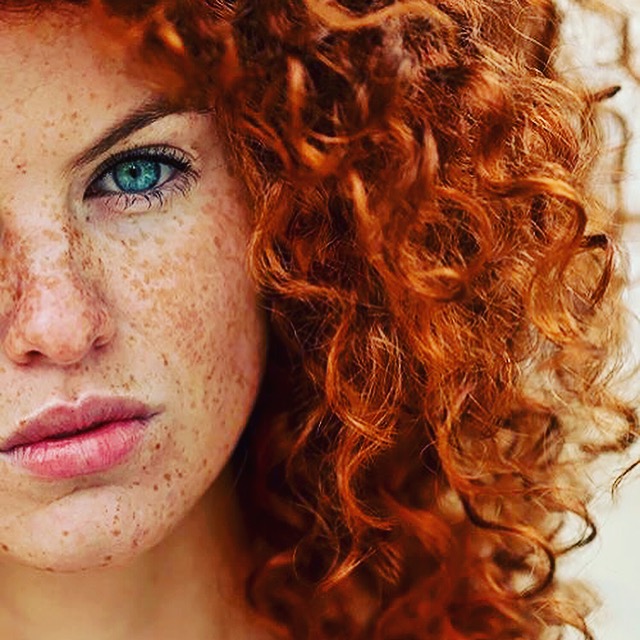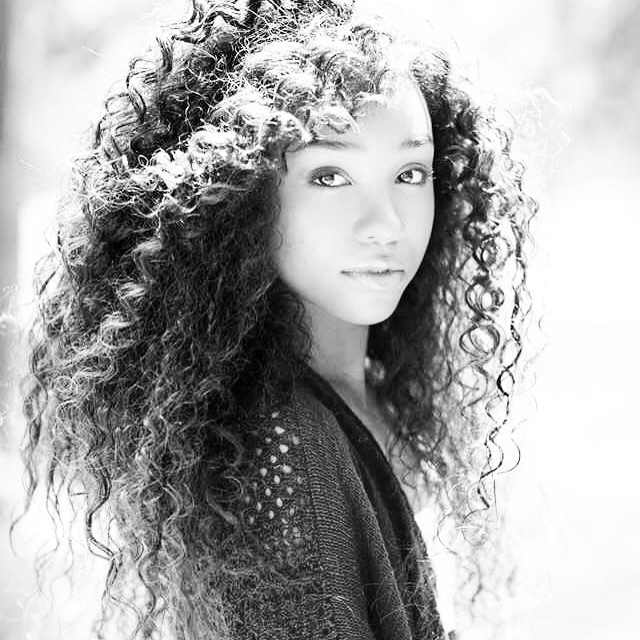Hair Science, Hair Concerns, Our Hair
TRICHOTILLOMANIA
Definition
Trichotillomania is a psychiatric condition in which an individual has an uncontrollable desire to pull out his own body hair. It is generally considered to be an impulse control disorder but is sometimes classified as either a subtype or variant of obsessive-compulsive disorder (OCD)
Description
 There is an immense amount of embarrassment and denial associated with trichotillomania. It is common for individuals with this disorder to deny their behavior and attempt to hide their hair loss. The hair loss may be disguised by wearing wigs, hats, scarves or hair clips, or by applying make-up or even by tattooing. The act of hair pulling is a private one. Rarely does the hair pulling occur in the presence of another, except for close family members. Because of this fact, social alienation is common in trichotillomania. The hair pulling may occur either when the individual is relaxed or under stress. For some individuals with trichotillomania, certain situations, such as watching TV, lying in bed, or talking on the phone, will trigger the behavior. The individual either may focus intensely on the hair pulling or the pulling may be done unconsciously. Immediately before pulling hair, the individual with trichotillomania feels a mounting tension. This tension is relieved as a hair root is successfully pulled. Since a tingling sensation is felt upon successfully pulling a hair follicle completely from its root, a neurodermatologic connection may reinforce hair pulling as a means of tension relief. When the hair root remains intact and the hair shaft is broken, this sensation is not felt and the patient may repetitively pull hairs until successful. After pulling the hair, patient may carefully examine the hair root, and the hair bulb may be rubbed along the lips for further stimulation. Trichotillomania usually begins in the preteens but has been reported in children as young as one year old and has been seen first in adults over 50 years old. Patients in their seventies may suffer from trichotillomania. The mean age of onset is 12 years of age in girls and eight years of age in boys. This condition is seven times more common in children than in adults. Among young children there is no gender preference. But among adults, it is reported up to 10 times more often in females than in males. This may be skewed because females are more likely to seek attention for a medical problem, and because it is easier for males to disguise their compulsions, e.g. by shaving or because of social acceptance of male pattern hair loss.
There is an immense amount of embarrassment and denial associated with trichotillomania. It is common for individuals with this disorder to deny their behavior and attempt to hide their hair loss. The hair loss may be disguised by wearing wigs, hats, scarves or hair clips, or by applying make-up or even by tattooing. The act of hair pulling is a private one. Rarely does the hair pulling occur in the presence of another, except for close family members. Because of this fact, social alienation is common in trichotillomania. The hair pulling may occur either when the individual is relaxed or under stress. For some individuals with trichotillomania, certain situations, such as watching TV, lying in bed, or talking on the phone, will trigger the behavior. The individual either may focus intensely on the hair pulling or the pulling may be done unconsciously. Immediately before pulling hair, the individual with trichotillomania feels a mounting tension. This tension is relieved as a hair root is successfully pulled. Since a tingling sensation is felt upon successfully pulling a hair follicle completely from its root, a neurodermatologic connection may reinforce hair pulling as a means of tension relief. When the hair root remains intact and the hair shaft is broken, this sensation is not felt and the patient may repetitively pull hairs until successful. After pulling the hair, patient may carefully examine the hair root, and the hair bulb may be rubbed along the lips for further stimulation. Trichotillomania usually begins in the preteens but has been reported in children as young as one year old and has been seen first in adults over 50 years old. Patients in their seventies may suffer from trichotillomania. The mean age of onset is 12 years of age in girls and eight years of age in boys. This condition is seven times more common in children than in adults. Among young children there is no gender preference. But among adults, it is reported up to 10 times more often in females than in males. This may be skewed because females are more likely to seek attention for a medical problem, and because it is easier for males to disguise their compulsions, e.g. by shaving or because of social acceptance of male pattern hair loss.
Causes and symptoms
There is no clear cause of trichotillomania, but there are psychoanalytical, behavioral, or biological theories for this disorder. Some of the more commonly accepted theories for trichotillomania are:
- childhood trauma
- stressful events
- neurochemical imbalance
The psychoanalytic model purports that trichotillomania occurs in an attempt to resolve a childhood trauma. The behavioral theory for trichotillomania states that a stressful event, such as moving or the loss of a loved one, or a family conflict precedes the onset of hair pulling and that hair pulling begins in an attempt to relieve tension caused by a stressful event. This behavior continues beyond the initial stimulus and eventually becomes habitual. Later the patient may not be aware of this initial trigger. For a child, the stressor may not be just a single event, but may occur in response to what a child may perceive as excessive demands from an authoritarian or an overbearing parent. Biological theories for trichotillomania include a neurochemical imbalance, such as a serotonin imbalance. Drugs that correct for serotonin imbalance improve symptoms in many with this disorder. Altered dopamine levels may also play a role in trichotillomania. It is not clear if genetic factors are involved in the development of trichotillomania, although some studies report an increased percentage of relatives with various psychiatric disorders. The most common symptom of trichotillomania is hair loss. The pattern of alopecia in trichotillomania varies among patients and the degree of hair loss will range from a barely noticeable thinning to total loss of hair. Some patients pull out hairs without regard for symmetry, while others will attempt to follow a pattern or pull out hairs in an effort to maintain symmetry of appearance. Usually, the hair loss on the head is patchy or poorly defined. There are neither scars nor any inflammation in the area of scalp hair loss. The top is the most affected region of the head. To ensure trichotillomania is a pattern hair loss of the scalp in which hair is present only at the nape and on the outer edge of the scalp. The eyelashes and eyebrows may be plucked off, and hair loss may be noted on the arms, legs, and body. Pubic hair may be sparse.
When to call the doctor
Any continuous pulling of hair or hair loss should be reported to a medical professional, as there are medical causes for hair pulling and hair loss, and if trichotillomania is the underlying cause for this problem, then medical and psychiatric treatment needs to be initiated as soon as possible, since the earlier the intervention, the greater the likelihood that the behavior can be controlled. It is important to realise that the occasional or infrequent twisting, pulling, or chewing of hair in a child does not constitute trichotillomania and does not require medical attention.
Diagnosis
The diagnosis of trichotillomania is made by history and interview, along with histological examination of the hairs in the area of hair loss as well as skin tissue in the area. All other medical causes of hair loss must be eliminated. Since patients are adept at disguising and denying the symptoms of trichotillomania, the condition may go on for years without detection or treatment. Most patients are embarrassed to admit to hair pulling and the resultant sequelae, and elicitation of this behavior is difficult. The patient will not usually report pain . All of this makes the diagnosis of trichotillomania difficult. The patient must be made to feel comfortable admitting to and then discussing the behavior.
According to the American Psychiatric Association there are five criteria which must be met in order for trichotillomania to be diagnosed. They are as follows:
- The hair pulling is recurrent and a noticeable pattern of hair loss is observed.
- The patient feels increased tension prior to the hair pulling.
- This tension is relieved upon pulling hairs.
- The pulling is not associated with another mental condition, and there is no medical cause for the hair pulling.
- The behavior interferes with or disrupts the patient’s social and work activities.
There is a subgroup of hair-pullers who do not meet the second and third criteria listed above. These individuals are less likely to hide their behavior and do not suffer from low self-esteem as frequently as those who meet all of the above criteria. There is some debate about whether these people have trichotillomania and about whether these criteria for diagnosis of trichotillomania are too restrictive. Histological examination of hair follicles and skin biopsies also help in the diagnosis of trichotillomania. In the areas of hair loss in trichotillomania there will be a mixture of short and longer hairs in the area of hair loss. Trichomalacia or distortion of the hair follicles is often present in trichotillomania. Trichotillomania must be differentiated from medical causes of hair loss and these include: skin conditions such as psoriasis ; trauma, such as that from radiation; endocrine disorders such as hypothyroidism ; infectious diseases such as herpes zoster; inflammation such that of the lids margins, called blepharitis; and tinea capitis, a fungal infection of the scalp. Other psychiatric disorders, such as schizophrenia , must also be ruled out.
Treatment
Usually, the patient with trichotillomania does not present for treatment until, on average, two years after the hair pulling has begun. Traditional treatment for trichotillomania involves psychological or behavioral therapy, or medication. Behavior modification, especially with children, helps the child to increase his or her awareness of the hair pulling. Behavioral therapy may be as simple as acknowledging the problem and instituting a plan for desensitization of the behavior. Habit reversal training (HRT), a cognitive behavioral therapy, has been successfully used in the treatment of trichotillomania. Under HRT treatment the patient acquires increased awareness of his or her actions and learns alternative behavior to the hair pulling. HRT has been employed in group therapy. Addressing the behavior of trichotillomania in a group setting is helpful so the patients realize that they are not the only ones with this problem. This experience also improves social interaction, as isolation is common among patients with trichotillomania. But for some with trichotillomania, behavioral therapy is more successful when drug therapy helps reduce the urge to pull hair. For these individuals, relapses are more frequent when pharmacotherapy is reduced or discontinued. Treatment of the resultant medical complications of hair pulling must be addressed. Carpal tunnel can develop from repetitive pulling. Infections at the site of the hair pulling and blepharitis at the eyelid margins can occur, both of which are treated with topical antibiotics and corticosteroids. If there is significant eyelash and eyebrow loss, called madarosis, blepheropigmentation or surgical tattooing can be performed. Although not done often, transplantation of hairs to these areas is possible. Topical application of colladion can help with regrowth of hair but will not be successful long term unless the underlying behavior is controlled. If the hair pulling continues for long periods without treatment, the alopecia may be permanent. Anemia, malnutrition , and digestive disorders, including bowel obstructions, can develop, if trichotillomania develops into trichotillophagia or eating of the hairs. Trichobezoars, or hairballs, can form when the hair is bitten off and ingested. For many with trichotillomania, hair pulling is not an activity that can be stopped at will. For some, however, the suppression of hair pulling may be possible, even if the underlying urge persists. The family needs to be a part of therapy since familial stressors may have triggered trichotillomania. Because of the shame involved with hair pulling the patient may have other medical problems which go untreated because he or she will not seek any medical care at all, for fear that hair pulling and its associated stigmata will be uncovered. Thus, it is important that once trichotillomania is diagnosed that the healthcare provider inquire into any other medical concerns that the patient may have.
Alternative Treatment
Hypnosis has been used in treatment of childhood trichotillomania. The Erickson approach of hypnosis helps the child to substitute hair pulling for a stroking behavior. Other approaches to hypnosis in trichotillomania teach the child that he or she has control over events in his or her life, including hair pulling. There are other hypnotic techniques that employ adverse conditioning, so that the hair pulling becomes associated with pain instead of pleasure. Other techniques, consider alternative, used to trichotillomania include biofeedback, yoga , and exercise .
Prognosis
When trichotillomania appears in early childhood, the duration of time during which the child is afflicted, is limited. The remission rate for children diagnosed before age six is high. For many children with trichotillomania, the condition resolves by adulthood. The prognosis is much more difficult for those who develop trichotillomania after age 13. These children have a higher rate of other co-existing psychiatric disorders. Unfortunately, among those individuals who need long-term treatment for trichotillomania, as is the case when the initial presentation occurs in late childhood or as in adolescence or in adulthood, there is a high relapse rate in spite of intervention. A lack of definitive cause for trichotillomania makes treatment difficult, and the prognosis for a total recovery is poor, although the behavior may be satisfactorily controlled with therapy.
Prevention
Since, as of 2004, the actual cause of trichotillomania was not known, there is no known means of prevention.
Parental concerns
Parents must realize that the earlier the treatment for trichotillomania is begun, the more likely that the hair pulling can be controlled. When trichotillomania strikes the adolescent it is especially important that the behavior be addressed and treated promptly. Adolescence is a time when self-esteem and independence are developing. If the adolescent does not have a positive body image, then fear or ridicule from family and peers can affect his or her ability to interact with others. Development of normal healthy relationships as an adult may be impaired if the family and such support mechanisms as therapy are not in place. Since often the family dynamics provoke this behavior, parental involvement in therapy is essential. If necessary, the parents must be open to establishing new boundaries within the parentchild relationship. It is important that parents to realise that trichotillomania is a complex and not completely understood behavior. But it is increasingly believed that trichotillomania has a biological basis, and thus parents must understand that they did not cause it and that they are not the only parents with a child who has trichotillomania.


